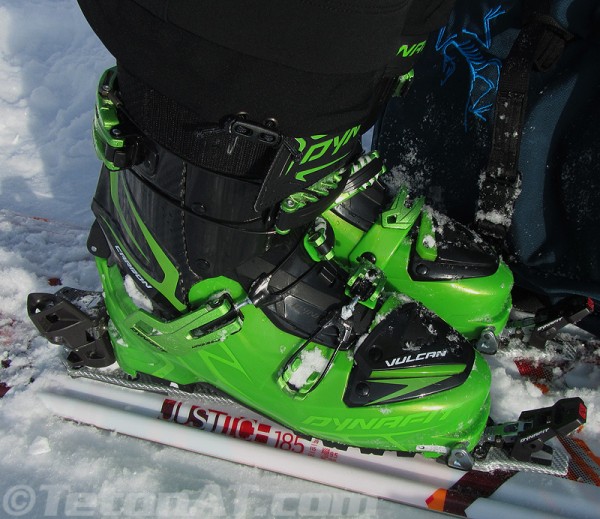
Click all photos for larger image.
Since Outdoor Retailer, I’ve been able get a couple ski tours in using the much anticipated Hoji-boot, AKA the Dynafit Vulcan, for next season. The Vulcan tours great and skis even better, as the cuff and flex pattern is very stiff. There were some parts of the boot that I didn’t like, mainly the buckles, but I think Dynafit is still fine-tuning them, so we will most likely see improvements in the production version.
Anyway, I figured I’d shoot a few side-by-side photos of the Vulcan and the TLT5’s (both shells are size 27/27.5), since folks are familiar with the TLT5 and can see the similarities and differences between the boots. I’m thinking a boot quiver of Vulcans and TLT5s would be pretty sweet next year, but it will cost you. If you are looking for a quiver of one boot, next year’s Dynafit One boot may be the better blend of lightweight and stiffness…while also saving you a few ounces as well.
Compared to the TLT5, the Vulcan is quite a bit higher in the cuff and larger in overall volume. The Vulcan has three buckles, one at the forefoot, one at the instep and one at the top of the cuff, while the TLT5 has a sort of hybrid forefoot/instep buckle down low and one buckle at the top of the cuff. Both boot’s ski/walk mechanisms work similarly in conjunction with the top buckle. Per boot, the Vulcan comes in at 1590g (3lbs 8oz) and the TLT5 Performance, 1050g (2lbs 5oz).
I found the top buckle on the Vulcan to be a pretty bulky and it didn’t want to sit very flat against the shell when open and in walk-mode, making putting the cuff of my ski pants over it a little difficult. Word is that a spring will be added to production models to help them stay open when unbuckled.
The middle buckle on the Vulcan has a set-it-and-forget-it latch, much like the top buckle. Because of this, I found it a little challenging to insert the tongue into the Vulcan without having to totally open the latch and totally undo the cable, which adds quite a bit of fiddle factor when prepping the boots for the descent. Again, I’ve heard Dynafit is working on tweaking the buckles a little, so hopefully this issue will be addressed. I could be “doing it wrong” as well, but time will tell.
The carbon cuff on the Vulcan is much more substantial than the TLT5 and also protrudes lower and higher in the back of the boot, which makes them ski quite stiff. I’ve heard some talk of the production model being about 20% stiffer in the shell, sole and tongue, than the samples out now. Personally, I like the stiffness as they are now, since increased stiffness probably means increased weight. However, I figure one could always shave a few ounces and ski the Vulcans without the tongue if they seem too stiff. But then again, that person should probably be looking at the One boot instead.
The powerstrap is wider on the Vulcan compared to the TLT5. It also has a feature that allows you to connect it to the tongue of the boot, instead of having it connect to the back of the cuff. This is pretty cool since if you are removing the tongue for the uphills…you really don’t need to use the powerstrap. So why have it on the boot, in the way and adding bulk?
Whether or not it is from the increased volume of the Vulcan’s last, or because of the longer tabs at the toe and heel to allow for the use of step-in AT bindings (like the Duke, Freeride Pro, etc…), the BSL for size 27/27.5 is 304mm. The TLT5s in the same size are 297mm. This means that with some Dynafit bindings (mainly the older Speed Classics…which I personally like) that only have a few millimeters of length adjustment, using both boots in the same ski/binding setup might be problematic. First-world problem…I know. 🙄
The widest part of the last in the fore-foot area of the Vulcan is 103mm, compared to 102mm in the TLT5. This will make a lot of people that had trouble fitting in the TLT5 rather happy. This will also allow for the use of thicker liners to keep your feet warm. Even with sizing up and using Intuition liners in my TLT5s, I found my toes still get pretty cold when the temps drop below ~0F. The thin shell of the TLT5 might be the culprit of my cold feet, as well as the openings in the shell as a result of the Acti-Flex area in the toe. I’m thinking the Vulcan will be a warmer boot overall since it doesn’t have the Acti-Flex and uses thicker plastic in its construction.
The removable tongues on the Vulcan are taller, more substantial and quite stiffer compared to the TLT5’s tongue. I think if Dynafit can just dial in the ease-of-insertion with the Vulcan tongue, and remove the need to undo the cable on the middle buckle, it should work great.
The sole of the Vulcan has two nubs/posts/round protrusions in the toe and heel area that work in conjugation with the AFD plates on “rail-type” AT bindings (Duke, Freeride Pro) to allow for a smoother and more consistent release out of the binding. Since the TLT5 doesn’t have big enough welts on the toe and heel to be compatible with these type of bindings, they are not needed.
The Vulcans (MSRP-$999.95/MAP-$849.95) are very nice IMO.   I think they are a great example showing that you don’t need four buckles to make a boot stiff, and any claims by a manufacturer having the lightest/stiffest four buckle boot should be ignored.  It will be interesting to see if folks will opt to save $160 and choose the non-carbon Mercury version instead, or even go for the lighter, softer and tongue-free One boots.  Regardless, Dynafit is really stepping it up in the AT boot department (again) for 2012/13, so be sure to eyeball these offerings next season.
(On a side note…after about one season of relatively hard use, I’d say my TLT5 Performance boots are on their last leg. I have popped rivets, broken cables and there is quite a bit of slop in the cuff rivet now that its starting to bother me. I’m not sure if the slop has developed as a result of the rivets expanding and coming loose, or if the carbon fiber has worn down due to friction around the rivet. I’m wondering if replacing the cuff rivets will snug things up?)

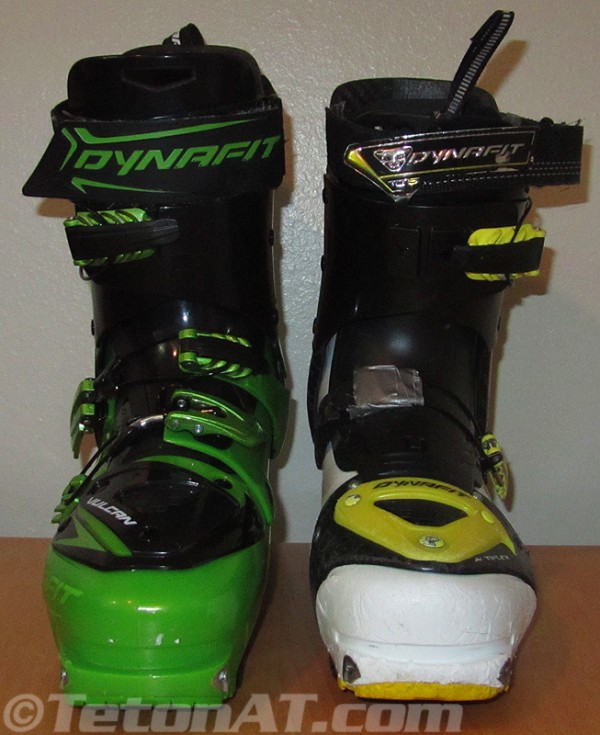
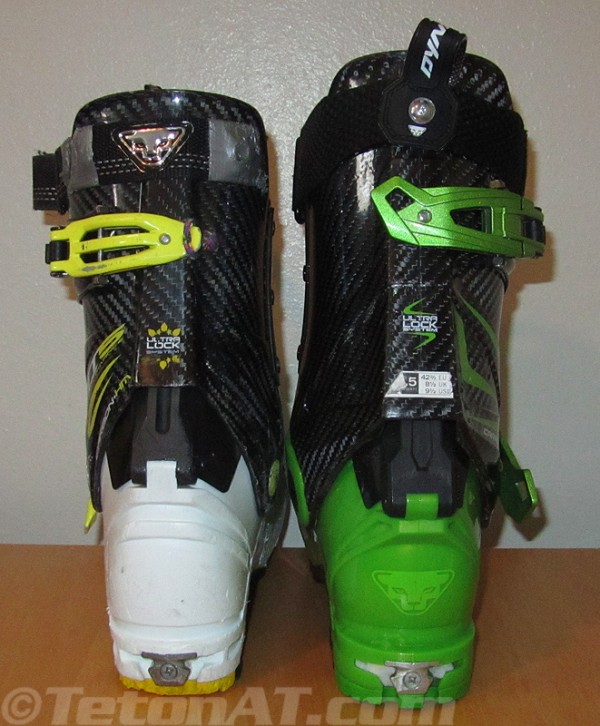
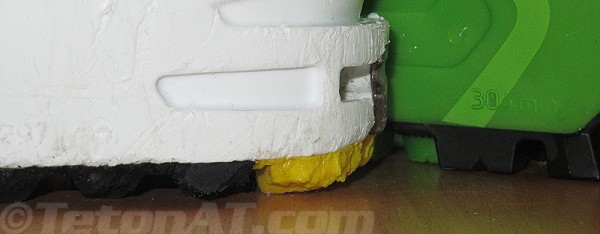
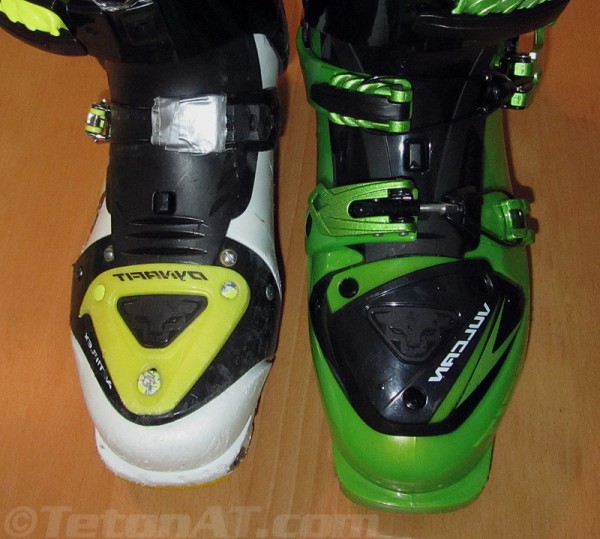
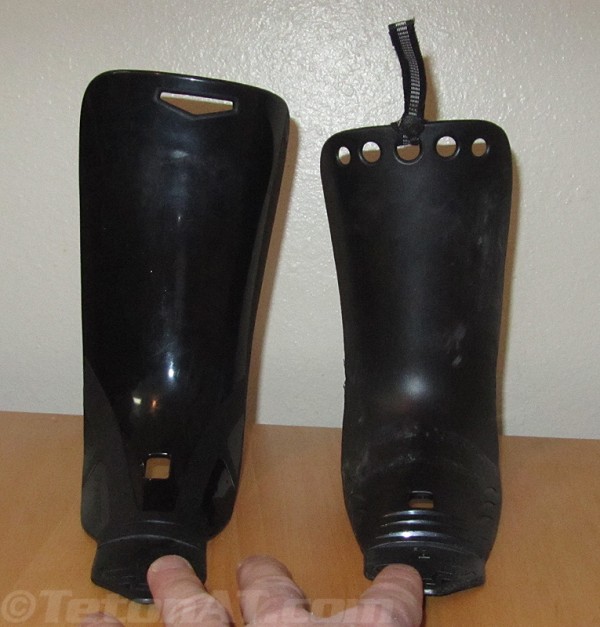
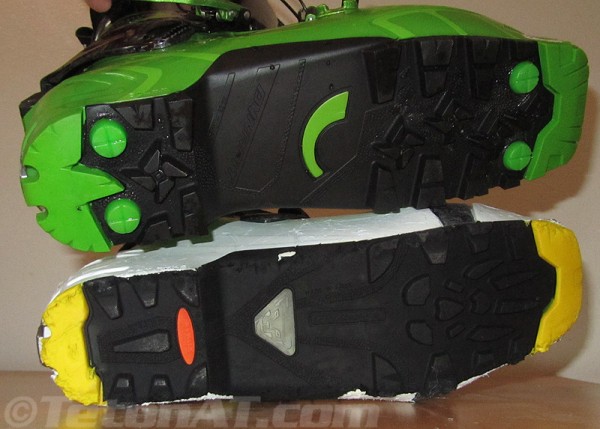
Hey Rando,
My friend and I both own the TLT5 Performance, and both of us developed quite a bit of slop in the cuff. My buddy’s dad owns a ski shop and does a lot of boot fitting. He took his boots to his dad who pressed his cuff rivets and the slop is gone. I was thinking that the carbon fiber was wearing away, but after this fix I’m convinced that the rivet is just splaying out.
Hey Steve,
Like Greg said, repressing the rivets should tighten them up nicely. I did it on Jonathon Shefftz’s DyNA boots and the carbon cuff is much thinner on there than the TLT5 P.
Steve – cool post, thanks! Man, I still really want some TLT5s, but fortunately the low snow year here in the Sierra is just not justifying the purchase. Will be nice to wait until next year to see if they make any of the “mods” many of you guys are publicizing into the actual production model. E.g., the ability to keep the upper buckle latched down (and out of the way), but still in walk mode.
“I did it on Jonathan Shefftz’s DyNA boots and the carbon cuff is much thinner on there than the TLT5 P.”
– I am pleased to report that despite my initial (and misplaced) skepticism (as I incorrectly thought the problem had to be irreversible wear & tear, not rivet slop), not only were they as good as new when I received them back in the fall, but with over 91,000 vertical since then, they are still nice & tight (with over 383,000 cumulative vertical)! (My TLT5 P though are finally starting to loosen up now with almost 309,000 vertical — should be good enough through the end of this season, then I’ll send them back to you in August for another little love hug from your rivet press!)
that is fantastic news, and i’m going to bring them to the shop at lunch today. i do have a back up pair of TLT5s though…just in case. 😎
How would you rate the flex compared to Factors and Titans? What do you think of the liners?
justin…i think the vulcans are at least as stiff as both the factor and titan. i haven’t tried the latest generation of factors though. obviously, the vulcans tour better than both.
i did not try the liners.
Would be interesting if you put the real Hoji boot up against that tlt5. The real boot is a modified Titan.
i dunno skian…with all that carbon, i think the vulcan would be stiffer.
http://tetonat.staging.wpengine.com/2011/06/30/hoji-fit/
nick…i have a mod on my tlt5s that lets me close the cuff buckle, but stay in walk mode.
honestly…i haven’t even tried it in the field because i have never felt the need to use the boots like that.
maybe for ice climbing? if so…i think i would also want to have the cuff buckle not as tight as i would want for skiing.
rivet update…looks like the re-pressing worked for 3 out of the 4 cuff rivets. (thanks kieth @ tm) pressing also tightened up some play in my cuff buckle. i was having trouble getting into ski mode before, so i’m hoping things line up better now.
i may sniff around for other fixes for the cuff rivets, as it would be nice to have a beater pair of tlt5s for the late season. i don’t think it will take much to loosen the rivets again.
Does anyone have problems with their TLT5’s ski/walk switch due to it being coupled with the top buckle? I have huge calves (Australian not Tongan) and must customize the diameter of the top buckle on every boot I own. With my Radiums I often ski with the top buckle open, but hooked at the second notch, and they still pinch. I like the TLT5’s except for that committed walk/ski switch based on the buckle.
Steve, any idea if the Vulcan will come with the same liner as the TLT5? I LOVE my TLT5 Mountain liner. Does a great job with blister AND temps due to the tight fit around my ankles/calves. Just curious if it is the same lace-up design…..
…almost forgot….do you feel the new buckles are better for boot packing? The TLT5s bottom buckle always gets knocked outta place when I boot through anything other than powder (i.e. crust)…..
How does the Vulcan compare to the Titan? My Titans fit great, drive a full range of skis, but could use more cuff range.
Quite clearly the cuffs on the Vulcans are taller than on the TLT5 – not arguing this point in the least. But it’s worth noting that sole thickness plays a big role here and looks can be deceiving. At first glance the TLT5 cuff seems low, and side by side it’s lower than my Titan of the same shell size. But if I put the liner from my TLT5 in the Titan, the Titan cuff comes up to the same point on the liner as the TLT5 cuff does. So I’ve concluded that the TLT5 isn’t any shorter than the Titan. But then, some have accused the Titan of having a short cuff!
I don’t know Steve? Carbon provides a strength to weight ratio but I wouldn’t get caught up in the power to performance ratio against a freeride boot. The Titan is a bigger boot than the Vulcan and in true performance I feel more power. The Titan with great articulation would be cheaper and also more powerful for full on freeride IMO. The Vulkan is a wider tlt5 without met flex and pushing the 1000.00 barrier. It is no Titan. Give a Titan 60 degrees of articulation strengthen up the puck interface with the boot and IMO you have a Jackson Slayer for big board big drop freeride and less expensive than a carbon Ferrari. Now if your talking ski mountaineering it’s another story. Light is right but weight is great. Ski mountaineers (me included) are keeping their skis on the snow and certainly not cranking heavy metal. All I see in the Vulkan is a wider platform TLT5 with no met flex. If your going big it’s not in the same cat as the Titan. By that I mean matching it up with a wide platform ski and a din 16 binding. You cant to that with a Vulkan. The Vulkan is a ski mountaineers dream not a freeride boosters boot. Look at the Dalbelo Krypton with walk mode. That is in the cat of the Titan. The world of freeride booters and Ski mountaineers is melding but go either direction and you are in compromise. That’s why we have quivers. Be safe out there!
omr…no problems. i’ve got think liners in my tlt5s. the top buckle is set in the widest spot on the cuff and i put the cable in the third slot. i also have big calves…but not that big.
ray…the vulcan liners will be different from the TLT5s. and yeah…better lower buckles that stay closed when booting. i can’t believe i haven’t broken off one of those tlt5 buckles yet.
john…the vulcans are a bit wider than the titans, taller in the cuff and as stiff, if not stiffer than the titan, IMO.
skian…have you tried the vulcans? if so, and you are making those statements, i would think were really stoned, or something, when you used them.
the vulcan is every bit as stiff as the titan and i would bet it is taller in the cuff. the titan might be “more powerful”, but not by much, if at all. the vulcan is light-years stiffer and beefier than a tlt5 and it is NOT just a wider boot.
i would easily call the vulcan a freeride boot….for those that like to hike for the ride down. it can easily drive big skis…like megawatt big…no problem. the titan is more of a sidecountry boot, where the vulcan is a more pure backcountry boot…on crack.
for that matter…i don’t think is is a ski-mountaineers boot. the one and tlt5s are better in that genre.
Hopefully, the Mercury will come close to the stiffness of the Titan since it sounds like the Vulcan will be stiffer (after the 20% increase). I don’t really want anything stiffer than the Titan and the Mercury saves some cash as well. I’ve seen no reports on the Mercury, however.
Isn’t the Titan an overlap boot? Vulcan and TLT tongue boots. The disagreement on stiffness might have something to do with this difference? The TLT felt really “stiff” to me in the shop, but on the snow it doesn’t drive a ski quite like the Titan. Maybe this is what skian refers to. I also love the real world cuff height comment, the TLT probably has a thinner sole… Overlap boots are ridiculously superior to tongue boots for skiing performance, they drive and absorb everything more smoothly.
How progressive is the forward flex?
I was able to tune the progressiveness of the forward flex of the Titans by making sure the tabs on the cuff and windows on the lower were simultaneously engaged, and enlarging the windows.
My Maestrales forward flex seems to depend on the flex of the shell, which changes with temperature. Inconsistant:(
I ski in Titans. They’re a comfortable and versatile touring boot, great for moderate powder skiing, but will never come close to the fit and performance of alpine boots. Describing Titans as a free-ride boot is ridiculous, they’ve a broad generic fit, and the whole shell deforms and collapses when you crank on them. I’ve been reading all the press on the Vulcan, and was getting excited about a high performance, low volume (similar to the TLT) boot that tours like a dream. I’ll pay for that. But you’re telling me that it’s wider and no more (and perhaps less) supportive/performing than the Titans, that I’ll have to dick around with removable tongue and awkward buckles. Increased range of motion is fine, but I can walk far and fast in my Titans. Why should I pay a premium for Vulcans?
Steve, While I might not of quit smoking pot my frequency over the years has become less frequent. I do know ski boots and yes I have been in the boot. A tlt5 is a speed boot and yes a ski mountaineering boot, a great boot for that matter. The Vulcan is in the same category and yes beefier. If you were going to stand around in cold condition all day I think the tlt5 is a bit thin in the insulation game. The Vulkan is the answer for that, provides that insulation and is a great ski mountaineering boot. It just happens that it is tall and has a wicked stiff sexy carbon cuff but it is built on a ski mountaineering last and a tongue not a performance alpine last. PU imo is still one of the best performance materials for a ski boot and the last of the Titan is tight 102ish not 104ish in the forefoot so when you roll that edge it is direct to the snow no slop. Progressive flex says alot also an alpine overlap skis better than a tongue boot no ifs ands or buts. As for skis If you consider a megawatt a big ski your not listening to what I said….heavy metal. Waist size is not as important as gram count for a powerful ski. More weight less deflection. Big boots drive big skis better. The Vulkin is a thing of beauty. Don’t get me wrong I think the TLT5 is one of the greatest boots ever made for ski mountaineering and touring.Still my boot of choice for backcountry. The vulkan is the next generation in that cat. Just the pure mass of the Titan and the performance last makes it better for driving the heavy metal than the Vulcan with big skis. Go demo a faction 13 with both…you be the judge and ski really fast. Love your blog,respect your view. You be safe this weekend!
bob…i should be able to get on some mercurys in the next week or two, and will let you know.
john…it’s hard to comment on progressive flex…as i haven’t been on titans in at least a year. i think the vulcans are stiffer than titans though.
stewart…you will be able to hike further, faster and ski more aggressively, in comfort, with the vulcans…more so than the titans.
they are lighter, stiffer and have WAY better walk mode than the titans. that’s what $1k will get you.
Nice review and comments. Any thoughts on how the Vulcan compares to the BD Factor and Quadrant regarding cuff height and stiffness? My assumption is they will tour better. Can’t imagine it has the beef of the Factor so is the Vulcan more similar to the Quad or somewhere in between? Or apples to oranges? I love my new-ish TLT5P but my Factors (prefer them for short/fast boot pack laps/tours, slack country and their “free-ride” feel) are showing their age.
Rob…the vulcan is just a touch lighter than the quadrant, but with a cuff height and similar stiffness to the factor. better walk-mode than both.
[…] […]
Ciao guys…
just a short but hopefully good infos…
Skian, are you “the Ian” I know? … well if yes you should better try a final Vulcan before saying it can’t ski better than a Titan… you know I know as well “something about boots” 😉 …
Honestly speaking, Vulcan is very stiff, on a winter cold day I would not recomend it if somebody is not a very good skier, very aggressive, and using big skis.
Titan is different, different construction and some intermiate skiers might prefer its peformance vs the vulcan… but for a top skier, what the Vulcan is targetet to, the Titan is way too soft.
By the way… the titan is already by far the stiffest and best performing of all the ski boots category with a ski walk mechanism, doesn’t matter which brand, so make your on calculation of what the Vulcan will be 😉
As regards overlap vs. tonge… despite of what I was “teaching” around some years ago when launching the titan/zzeus concepts… the new trends and the modern freeriders, due to the evolution of skis and techniques, likes much more tongue construction boots. That’s why the kripton is one of the favourite boots from freeriders… and that’s why we decided to move the TLT5 platform toward freeriding using a tongue construction. Which is removable… so you have the + for the descent without being unable to walk up … just remove it.
Having a titan with a bigger rotation of the cuff is technically impossible and the play developed by classic sky/walk mechanism with the metal bar will be HUGE and make impossible to reach the level of performance required. That’s why the TLT5 ski so nicely for it’s weight… thanks to the ski/walk system 😉
Moreover I’m very CONVINCED that at the end a freerider which is spending 1000$ to buy a dynafit boots is looking for something more than just a good downnhill boot. You can get a FANTASTIC alpine boot for 500$ … if you buy a Dynafit you need lightness, walkability, top performance (depending on the category) and crazy materials like carbon (expensive) …
Note that noone of the very few pais around are final, the changes will influence deeply the liners, the shell construction (20% more plastic in the area where it was too soft … only 10gr addition) thicker and stiffer tongue, also about 20%, etc.
The buckles on the cuff will be better working but Steve, TO add REMOVE the tongue it will be a MUST to totally open the central buckle. It’s technically impossible to work with the buckle still closed. It takes a few second more to add the tongue but considering the different target of this boot Vs. the TLT5 I’m sure it’s not a big deal. If somebody is in a rush on the summits and wants to climb 5 summits in a day he should still get a TLT5 P …
As regars the rivet popping issues on TLT5 and co … I just say that no boots is lasting forever… and to “normal people” not to worry too much. Peple like Steve, Johnatan and co. are skiing nearly every day on their boots as well at a top level. That means what they do in a season is what a good skier is doing in 3-4. So cool to see that Jonhatan is still more or less fine with 300.000 mt on his TLT5 … but honestly how many years somebody else needs to make that meters?.
This is not an excuse and I also would dream/pretend more and more durabiliy and that’s what we fight every day to improve and find new solution, especially on very expensive product.
In addition … lighter and more performing in most of the cases and sports… means more expensive and less durable… what we are trying to do in the last years is trying to move forward a very stable and booring industry like ski boots … of course taking more risks using new materials, reducing weights… and always fighting with technical developers which knows exactly that doing so the risk for durability and quality complains might increase…
But we are deeply convinced this is the right way, we need innovation to make all of you skiers happier with their gears…
For who doesn’t knows I’m the PM of dynafit footwear line since the beginning of the new era 😉
Ah steve, by the way, where did you found out that the TLT5 last is 98??? it’s 102mm! but anyway as you surely know that is the measure of the internal shell last so everythinig depends from the liner inside.
Moreover fit is a three dimensional thing so how wide in mm the wider part of the forefoot is count nearly nothing in reality .. it depends on the last volume and shape etc…
Guys don’t stick too much on useless “marketing” numbers like that or flex index… try boots by your own and chose the one which fits best, perform better for your taste/style, you likes more… and has a price you can afford 😉
fede…thanks a lot for that.
the 98mm was written in my notes from the trade show, so someone must have told me the TLT5 was 98mm.
anyway…thanks for the added info on the boots.
Federico said: “the titan is already by far the stiffest and best performing of all the ski boots category with a ski walk mechanism”
I think many would argue that the Tecnica Cochise surpassed the Titan this year (and the Cochise Pro will be even stiffer next year). I haven’t tried them so I couldn’t say.
Steve,
Are you sure the One boot will have no tongue? In pics it looks like it has one. Are you planning to try that one out? I’m interested if it is worthwhile for the small weight savings or whether I should just go for Vulcan or Mercury.
I wish these boots were dynafit compatible only for a little extra weight loss.
scott…if i recall, the one has a “pseudo-tongue”, similar is on the tlt5 when you remove the removable tongue.
like i stated above…i will have a chance to try the ones soon. i think next week.
did you mean to say that you wished these boots were NOT dynafit compatible?
to me…that seems like an odd request. since going with a tech binding will be much lighter than any rail-type AT binding.
Sorry, I misread. I thought I had read that you were trying the Mercurys.
As for binding compatability, I wish these boots were like the TLT5, which isn’t compatible with anything but a dynafit binding. I’m assuming that saves XXg of plastic or so and makes the sole a little shorter. Dynafit must beleive that a significant number of people will be buying these boots to use them with Marker’s or Fritschi’s. Maybe they will.
Scott…I should be able to try both the ones and the mercurys.
I’m curious how much stiffer the Vulcan really is compared to the Mercury, it will be interesting to get your take. Steve, you’ve been in the TLTs for a while and now these, whats your thought on the removable tongue? I can obviously see the benefit of it, it just adds fiddle factor. I could see situation like high wind, or awkward transition spots on a steep slope where putting the tongues in before skiing would be a PITA. If you need to open the second buckle of the Vulcans completely to put the tongue in, then the “set-it-and-forget-it latch” seems like a poor choice, because its just one more thing to have to do, and wouldn’t seem like it offered any signficant benefit.
justin…i definitely like the removeable tongues and keep them out for most skinning. i do however, try to anticipate awkward instances when i might need to put them in by…putting them on before booting up a couloir or in a sheltered spot from the wind before a summit. the tongue is much easier to put in on the TLT5s than the vulcans.
So I just read on your review of the Dynafit Ones that your normal size is a 26.5 which is my size in Dyanfit Gaias(Titans) yet your review of the Vulcans is a 27. I chanced it and bought a slightly roomier 27 TLT 5 so I could stuff a thicker (warmer)liner in it and am very happy with that larger size. What size are you in the Vulcans and is the liner a little thicker than the TLT 5’s?
ellen…i normatlly were a 26.5 in titans and z-zeros. in tlt5s..i went with 27 and they fit great with an intuition liner.
i’m not totally sure what size i would be in the vulcans. the 27’s work okay when i put an intuition liner from my quadrants in them…but i might be able to get away with the 26/26.5 shell as well. the 26/26.5 shell size is not available to try yet…so i just don’t know.
the vulcan liner will no doubt be thicker than the tlt5 liners…but it also isn’t finalized yet.